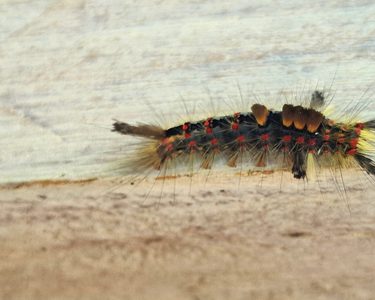Love your caterpillars

There are few sights more stirring than Lepidoptera on the wing. But, like the song flight of a skylark at dawn or the snuffling of a hedgehog at dusk, a butterfly or moth fluttering by is fast becoming a reminder of summers past.
A 2022 report – The State of the UK’s Butterflies – revealed that 80 per cent of butterflies have declined in abundance and/or distribution since the 1970s. And a 33% overall decline in abundance of moths in the last 50 years. This is hugely alarming given their role as an indicator species for insects: their short life cycle meaning they react quickly to environmental changes.
Besides their beauty, Britain’s 57 resident butterfly species – and 2,500 species of moths - bring numerous ecological benefits to our gardens. They play a key role as pollinators, with specialist mouthparts (probosces) to extract nectar from some of our rarest wildflowers.
In addition, their caterpillars are an important part of the food chain for bats and birds, particularly blue tits, which predate their caterpillars to feed their young. Parasitic flies and wasps also consider them a tasty host to consume from the inside out.
Why caterpillar plants matter
Butterflies and moths are famously fussy about where they lay their eggs. Caterpillars of the orange-tip butterfly for instance depend on cuckooflower (Cardamine pratensis) and garlic mustard (Alliaria petiolata), while the rare Duke of Burgundy butterfly depends on cowslips and primroses (Primula vulgaris). This dependence on drought-sensitive plants makes their caterpillars incredibly vulnerable.
Hot, sunny weather, and warm nights are an advantage, but problems arise when droughts hit. These can kill the plants that new eggs are developing on, so that when the caterpillars hatch, the plant has shrivelled away to nothing, and there’s no back up.
As well as pesticide free garden environment, we also need to think about more plants for the crucial egg-laying stage. Try adding, or encouraging, some of these favourite caterpillar food plants to your garden this summer and autumn. And don’t be too quick to dispense with all-important weeds.
Best caterpillar food plants
- Scarlet Tiger moth – comfrey (Symphytum officianle).
- Brimstone butterfly – buckthorn (Rhamnus cathartica); alder buckthorn (Frangula alnus).
- Elephant hawk-moth – fuschia.
- Green-veined white butterfly – many plants including garlic mustard (Alliaria petiolata); cuckooflower (Cardamine pratensis); hedge mustard (Sisymbrium officinale); watercress (Rorippa nasturtium-aquaticum); charlock (Sinapis arvensis); large bittercress (C. amara); wild cabbage (Brassica oleracea); wild radish (Raphanus raphanistrum); nasturtium (Tropaeolum majus).
- Mint moth – marjoram (Origanum vulgare) and mint (Mentha spp).
- Large white butterfly – cultivated cabbage, Brussels sprouts, broccoli, etc (Brassica oleracea); nasturtium (Tropaeolum majus); wild mignonette (Reseda lutea); sea kale (Crambe maritima).
- Streamer, Barred Yellow and Shoulder Stripe moth – dog rose (Rosa canina).
- Meadow brown butterfly – grasses including fescues (Festuca spp); bents (Agrostis spp); meadow-grasses (Poa spp); cock’s-foot (Dactylis glomerata); downy oat-grass (Helictotrichon pubescens).
- Holly blue – many shrubs including holly (Ilex aquifolium); ivy (Hedera helix); dogwoods (Cornus spp); snowberries (Symphoricarpos spp).
- Vapourer moth - caterpillars feed on a wide variety of common trees and shrubs, including blackthorn, oak, hazel, hawthorn, willow, and elm.
- Common blue – common bird’s-foot trefoil (Lotus corniculatus); white clover (Trifolium repens).
This article is an edited version of feature written by Liz Potter in the summer 2023 issue of The Organic Way.